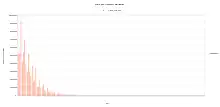質數間隙
質數間隙是指兩個相鄰質數間的差值。第n個質數間隙,標記為gn 或g(pn),指第n個質數和第n+1個質數間的差值,即

可知,g1 = 1、g2 = g3 = 2,以及g4 = 4。由質數間隙組成的數列(gn) 已被廣泛地研究,但仍有許多問題及猜想尚未獲得解答。
前30個質數間隙為:
- 1, 2, 2, 4, 2, 4, 2, 4, 6, 2, 6, 4, 2, 4, 6, 6, 2, 6, 4, 2, 6, 4, 6, 8, 4, 2, 4, 2, 4, 14 A001223.
由gn 的定義,可得gn 及第n+1個質數的關係式如下:
- .
張益唐在2013年證明說,存在有無限多對質數,其間隙小於七千萬,之後於同年十一月,詹姆斯·梅纳德用精進版的GPY篩法將張益唐的七千萬改進至600,而由陶哲轩发起的Polymath計畫將這數字降到246。[1]
簡單觀察
第1個、最小,且唯一為奇數的質數間隙為1,是在唯一「一個偶質數2」與「第一個奇質數3」之間的質數間隙。剩下的其他質數間隙均為偶數。在3個相鄰的質數間的1對質數間隙均為質數,只有在質數3、5及7之間的g2 及g3 一種而已。
對任一質數P,可定義一質數乘積P#,為所有小於等於P的質數之乘積。若Q為P之後的質數,則數列
為由相鄰的Q-2個合數組成的數列,亦即存在一個長度至少為Q-1的質數間隙。因此,質數間的間隙可以是任意大的,亦即對任一質數P,總存在一個整數n,使得gn ≥ P。(可選定n,使得pn為小於P# + 2 的最大質數)另外,依據《質數定理》,質數的密度會隨著數值增大而趨近於0,亦可知存在任意大的質數間隙。實際上,依《質數定理》,P# 的值約略為 exp(P)的大小,且於 exp(P)附近,相鄰質數的「平均」間隙為 P。
實際上,質數間隙為P 的數可能會遠小於P#。例如,由71個相鄰合數組成的最小數列介於31398至31468間,但71#有「27個數位」,其完整的十進位表示為 557940830126698960967415390。
孿生質數猜想主張存在無限多個整數n,使得 gn = 2。
參考資料
- . Polymath. [2013-07-21]. (原始内容存档于February 28, 2020).
- Guy, Richard K. 3rd. Springer-Verlag. 2004. ISBN 978-0-387-20860-2. Zbl 1058.11001.
外部連結
- Thomas R. Nicely, Some Results of Computational Research in Prime Numbers -- Computational Number Theory. This reference web site includes a list of all first known occurrence prime gaps.
- 埃里克·韦斯坦因. . MathWorld.
- . PlanetMath.
- Armin Shams, Re-extending Chebyshev's theorem about Bertrand's conjecture (页面存档备份,存于), does not involve an 'arbitrarily big' constant as some other reported results.
- Chris Caldwell, Gaps Between Primes (页面存档备份,存于); an elementary introduction
- www.primegaps.com (页面存档备份,存于) A study of the gaps between consecutive prime numbers
- Andrew Granville, Primes in Intervals of Bounded Length (页面存档备份,存于); overview of the results obtained so far up to and including James Maynard's work of November 2013.